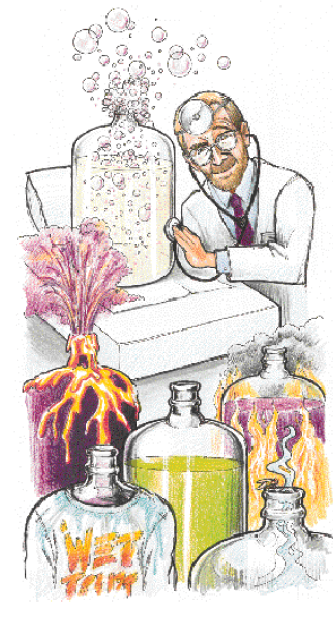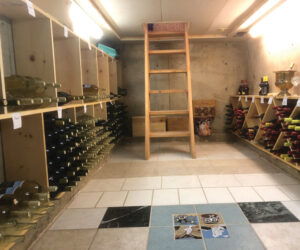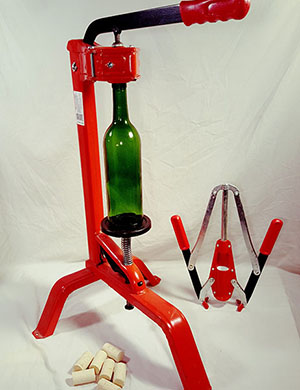 Your wine won’t ferment. It ferments too quickly. It ferments too slowly. It won’t quit fermenting at all! The wine won’t clear in the carboy. No, wait: It’s clear in the carboy but goes cloudy in the bottle! There are lumps of yeast floating in your fermenter and it’s the wrong color. Goodness gracious, what is that smell? These are some of the problems associated with kit wines gone awry. What follows is a high-threat troubleshooting guide for those times when good wine kits take a bad turn.
Your wine won’t ferment. It ferments too quickly. It ferments too slowly. It won’t quit fermenting at all! The wine won’t clear in the carboy. No, wait: It’s clear in the carboy but goes cloudy in the bottle! There are lumps of yeast floating in your fermenter and it’s the wrong color. Goodness gracious, what is that smell? These are some of the problems associated with kit wines gone awry. What follows is a high-threat troubleshooting guide for those times when good wine kits take a bad turn.
Before you do anything, you need to carefully re-read your kit instructions. Wine kits sometimes have instructions and procedures that contradict accepted techniques for typical winemaking and the instructions of other kits. There are many good reasons for these non-intuitive procedures, but they all boil down to the same thing: Wine kit manufacturers have tested their instructions and administered lab trials to ensure the best possible fermentation, clearing and stabilizing for each kit — so follow these instructions to a T!
Any departure from these instructions is the number two cause of kit wine failure (the leading cause being inadequate sanitation). If you’ve sanitized correctly, followed your kit’s instructions and still have a problem: It’s time for kit first aid!
These fixes, while applicable to almost all wines, are specifically designed to work with kits. Kits, as I am fond of pointing out, are not the same things as fresh grapes and fresh juice. Not only do you need to follow the right directions for the kits, you also have to apply the correct fixes!
Fermentation Follies
Wine Won’t Ferment
1. The Gravity of the Situation
When yeast is pitched according to kit instructions, you should see activity within 48 hours, or at least a nice, healthy scum of developing yeast on top of the must. If not, the first step is to take a specific gravity reading. If it shows a drop from the original, you’re experiencing “secret yeast.” For several and complex reasons, sometimes yeast like to hide, quietly getting to work without too much foaming or fizzing. In this case the immediate solution is to relax and to take another specific gravity reading a day later.
2. Cool Things Down
If you know you added yeast, check the temperature of the must. Kit wines are all designed to ferment at room temperature, generally a range of 65 to 78° F (18–26 ºC). If it’s much above 90 °F (32 ºC), you may have added too much hot water to the must and your yeast is likely dead. Cool the must by freezing a couple of bottles of water, sanitizing the outside and dropping them into the fermenter. Alternately, you can drape a wet towel or T-shirt around the fermenter and direct a fan at it. When the temperature is below the recommended maximum in your instructions, pitch a fresh package of yeast.
3. Or Heat Things Up
If the temperature of the must is below 65 °F (18 ºC), warm the must by wrapping it with a heating belt (available through your supply shop). Most of the time the yeast will begin fermenting within 24 hours, but if not, double-check the temperature of the must and pitch another package of yeast.
Wine is Fermenting too Quickly or Slowly
1. Is it Hot in Here?
If your wine ferments to dryness in less than half the time required in the instructions, your temperatures may be too high. Try the wet towel trick described above to cool it down. The trouble with hot fermentation is that yeast tends to generate its own heat after a certain point and you could have a heat-related yeast die-off and a stuck fermentation later.
2. Timing is Everything
If your wine ferments to dryness in less time than specified in the kit instructions, wait the minimum amount of days indicated in the instructions before racking to the secondary fermenter. For example, if the instructions say to wait 5 to 7 days, until the gravity is below 1.020, and you achieve 1.020 on the third day, cool the fermentation down to the temperature specified in your instructions and wait until day 5 before racking. This will ensure that an appropriate amount of sediment is left behind in the primary, and could prevent problems with fining and clearing later.
Wine Won’t Quit Fermenting
1. Zero In On Gravity
Sometimes a carboy will continue to bubble, long after it should have stopped. First things first: Check your specific gravity. If it’s high, give the wine a good stir, making sure the temperature is at the high end of the specified range and practice patience.
2. Fake Fermentation
If it’s in the right range, as listed in the instructions, you may be experiencing a common phenomenon. Your wine may actually be finished fermenting, but due to changes in temperature or barometric pressure it is out-gassing carbon dioxide at a rate that looks like active fermentation. This could be exacerbated if your wine fermented quite slowly (as in a cool fermentation) and is saturated with CO2.
My Wine Doesn’t Look Right!
The Wine Won’t Clear
First, don’t bottle cloudy wine. It won’t clear in the bottle, and any extra treatment to clear it up will require you to dump out all the bottles, process it and re-bottle.
1. Steer Clear of Filtering
Second, don’t filter the wine to clear it. Filtering is only good for clearing wines that are already almost completely clear. Fining agents still in suspension will sail straight into your filter pads, blocking them up quickly, and the ones that make it through will show up as sediment later on!
2. Fining: Stir Things Up
First go back to the instructions and make sure you followed the fining procedures exactly. The instructions regarding fining all contain the same phrase: “Stir vigorously,” which actually means really, really vigorously. In order for the finings to have the proper effect on the wine, it needs to be free of carbon dioxide. If it’s not, the bubbles of CO2 will float the fining particles back into suspension, over and over again and nothing will settle out. Be sure to stir the wine until it stops fizzing.
Clear Wine Goes Cloudy in the Bottle
1. Fermentation Not Finished
You can determine if the wine is continuing to ferment in the bottle by taking a sample and checking both the specific gravity and the level of CO2. If the specific gravity is higher than that recommended in your instructions for bottling, and it has a significant amount of CO2, you will need to un-bottle all of it and let it finish fermenting.
2. Fermentation Contamination
If the specific gravity is at or below the levels recommended in your instructions, but the wine is fizzy with CO2 and hazy, you may have a microbial infection. There are thousands of potential culprits, from lactic acid bacteria (spontaneous malolactic) to Acetobacter (vinegar) to air-breathing mutant yeast: All will ferment your wine after it has achieved what should be your terminal specific gravity. In this case you will need to un-bottle it, re-stabilize it with more sulfite and filter it. It will need to remain in the carboy until you are completely sure it will not ferment again in the bottle.
3. A Good Source of Protein
Protein haze is by far the most common of the three scenarios. Sometimes a fining agent will fail to clear all of the big proteins in a wine kit, or in some cases, traces of a protein-based fining agent (gelatin, isinglass) will stay in solution. When the temperature of the wine changes, these proteins become visible as a haze. As it warms up again, the haze disappears. Proteins are usually taken care of with the bentonite included in kits, but if you do have a protein haze, a small addition of thoroughly-rehydrated bentonite should take care of it. Try adding 15 grams per six gallons (three teaspoons). Wait two weeks and check the wine again.
That’s not the Right Color!
Kit is Too Dark or Too Light
1. Inconsistent Kit Color
Wine kit manufacturers are in an odd position: They make a packaged food out of a variable agricultural product. In this respect they are like producers of bread or pasta, who face harvest differences from year to year. They both blend raw materials from different areas to achieve consistent quality — kit manufacturers using grapes, rather than wheat, in this case.
However, even when all of the grapes in a kit come from a specific area, it may not be possible to completely blend away the color and flavor differences. Commercial wineries acknowledge this, and celebrate the different harvests by doing vintage tastings. Kits, however, are going to vary a bit from year to year, and unless the color change is marked by some other change (such as a loss of aroma or bouquet) you may not want to do anything to change it.
2. If You Want to Change
There are coloring products on the market, such as Grapeskin Extract and Exberry, which can be used to darken a red wine. If you must use them, follow the package directions, but keep in mind that they are not very stable colors, and could combine with any proteins in the wine and fall out of suspension later on.
What’s That Awful Smell?
Wine Smells like Matches
1. Mega-Bisulfite
Your wine may have too much sulfite, which is characterized by a “burnt match” smell, often accompanied by a tickling in the nose. However, the true level of sulfite can’t really be determined without a proper test. Until you’ve had your wine accurately tested, don’t attempt any correction of the sulfite level. Consult your instructions for the correct sulfite level in the kit.
2. Aerating
Minor excesses of sulfite (an extra 10 or 25 PPM) can be driven off by stirring small amounts of oxygen into the wine, effectively volatizing the free sulfite or binding it into bound sulfite, taking it out of action. You can stir air into the wine with a spoon, rack it with plenty of splashing, or bubble air into it with a brand-new, sanitized fish tank aerator for a short period of time. As always, test, adjust and test again.
3. Peroxide
Larger amounts of sulfite (up to an extra 50 to 100 PPM) can sometimes be treated with a hydrogen peroxide addition. Hydrogen peroxide is a very potent oxidizer. In high concentration it is used as part of the fuel mixture in rocket engines, oxidizing the fuel so rapidly as to resemble an explosion. It does the same thing in wine, oxidizing the sulfite, taking it out of action. For every 10-PPM of sulfite to be removed in 6 gallons of wine, add 4.2 ml of regular drug-store hydrogen peroxide. You must use a brand-new bottle of 3% USP-grade hydrogen peroxide, measure with a syringe to get accurate results, and above all, test before and after your adjustments are made.
Wine Smells like Rotten Eggs
1. Your Yeast Strain
Most yeast produces a small amount of hydrogen sulfide (H2S) during fermentation, producing a whiff of rotten egg. Certain yeast are famous for producing large amounts of this aroma, the Montrachet strain being particularly prone. However, this is rare in wine kits, as excess H2S is usually a symptom of low nutrients in the must, or too many grape solids — conditions that don’t apply to wine kits.
2. Air, Not Copper
If you do get this problem it can sometimes be cured by aeration, like the treatment for small amounts of excess sulfite. If it’s worse than a whiff, the fix used to be to treat the wine with copper, either in the form of metallic copper (a handful of sanitized pennies tossed in the carboy) or with a product called Cufex, which is a copper sulfate compound. The problem with this is that even in small amounts, copper is toxic to humans.
The Sunny Side of the Street
The good news in all of this is that most of these problems are actually very rare. Of the hundreds of thousands of wine kits sold every year, we see very few cases of real defects in processing. It turns out that kit winemakers are pretty savvy for the most part. With good sanitation, accurate measurements of temperature and gravity, and detailed record-keeping, you should never see most of these problems. But if you do, don’t panic: Most of the common conditions are easily fixed. Check out your options, and if you get stuck, call your retailer. Most winemaking stores have been in business a long time, and like me they’ve seen it all. They’ll help you get back on the right track, pronto.
Using Juices & Frozen Musts
Making wine from juice requires a bit more hands-on attention than making wines from kits. Unlike wine kits, fresh juices often have no additive pack or instructions. Those details are left up to you, the winemaker, to obtain and follow. Likely, no pH, acid or sugar balancing has been administered on the juice. Using juice does not need to be intimidating, however. The learning curve is actually more gentle than that of fresh grape winemaking. Pure, untouched juices open the door for creativity. It is a great way to begin experimenting with different varietals and techniques.
Juice usually comes in a 5 or 6-gallon (19 or 23 L) pail. Juices are either sold sterile or fresh. Sterile juices are preserved with sulfite to prevent spoilage or premature fermentation. The acid, pH and sugar may already be adjusted. Even the color should be correct per varietal or blend.
With fresh juices, the quality of the unpreserved juice is dependent on the year and location it was harvested. Fresh juice is sold as-is, while quantities last. Without preservatives, it might have little or no shelf life.
Some juices are put in cold storage. The almost freezing temperatures stifle spoilage and fermentation of natural yeasts in the must. But before you are ready to jump into juice winemaking, you’ll need to master some basic skills that require a little know-how in the science department. You’ll need to learn how to test acid and pH levels and how to manage sulfites and yeast. The “Winemaking Science” section starting on the next page is a general overview to prepare you.
Frozen musts are also an option and are more readily available than ever. Frozen must can come from any region of the world and include a growing list of available varietals.
There are many advantages to working with frozen musts for beginning winemakers. Besides the advantage of having must available anytime, your capital investment in winemaking equipment can be avoided, minimized, or delayed until you really want to work with fresh fruit. You do not need a crusher/destemmer, but you will still need a wine press for the red grapes to separate the liquid from the solids. Whites are usually already in juice form (reds usually come with the skins). Further, frozen musts eliminate the lifting effort of loading the fresh grape lugs into the crusher/destemmer. Contact your local fresh grape purveyor or scout out the Internet for frozen must sources.
Once you have some experience with kit wines, you may decide to experiment with grape juices. Rather than jumping straight into the vineyard and picking or purchasing wine grapes in need of crushing, winemakers can purchase a variety of sterile and fresh juices.







